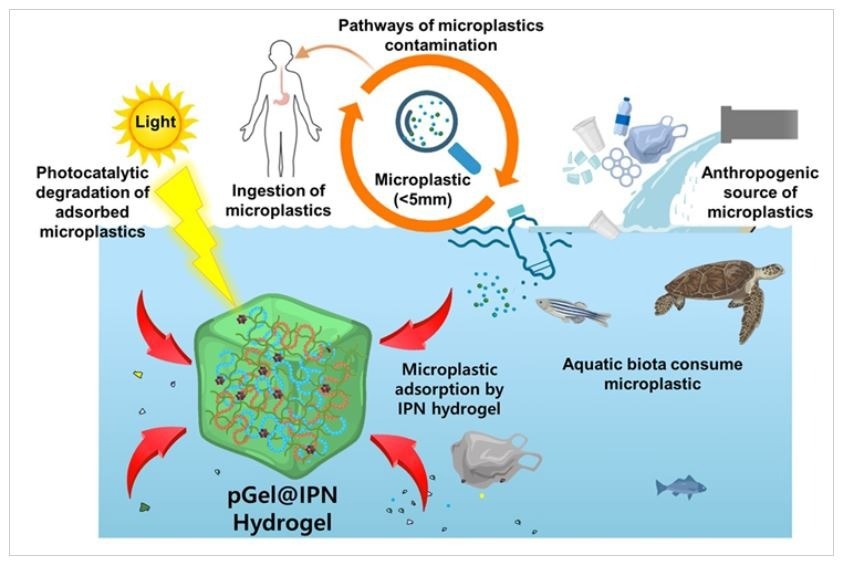Microplastics pose a great threat to human health. These tiny pieces of plastic can enter our bodies through the water we drink and increase our risk of illnesses. They are also an environmental hazard; found even in remote areas like polar ice caps and deep ocean trenches, they endanger aquatic and terrestrial lifeforms.

Addressing microplastic contamination in water with engineered 3D pGel@IPN hydrogel. Image Credit: Soumi Dutta
To fight this rising contaminant, researchers at the Indian Institute of Science (IISc) created a sustainable hydrogel that removes microplastics from water. The material contains a unique interwoven polymer network that can bind and destroy pollutants when exposed to UV light.
Previously, scientists attempted to remove microplastics via filtering membranes. However, these little particles clog the membranes, making them unsustainable. Instead, the IISc team, led by Suryasarathi Bose, a Professor in the Department of Materials Engineering, chose to use 3D hydrogels.
The team’s innovative hydrogel is made up of three separate polymer layers (chitosan, polyvinyl alcohol, and polyaniline) that are interlaced to form an Interpenetrating Polymer Network (IPN) architecture. The scientists filled this matrix with nanoclusters of a substance known as copper substitute polyoxometalate (Cu-POM).
These nanoclusters act as a catalyst to degrade the microplastics using UV light. The combination of the polymers and nanoclusters resulted in a strong hydrogel with the ability to adsorb and degrade large amounts of microplastics.
The majority of microplastics originate from the incomplete breakdown of household plastics and fibers. To simulate this process in the laboratory, the team pulverized food container lids and other commonly used plastic products, resulting in the creation of two prevalent types of microplastics found in nature: polyvinyl chloride and polypropylene.
Along with treatment or removal of microplastics, another major problem is detection. Because these are very small particles, you cannot see them with the naked eye.
Soumi Dutta, Study First Author and Postdoctoral Fellow, Department of Materials Engineering, Indian Institute of Science
To address this issue, the researchers added a fluorescent dye to the microplastics to monitor how much was absorbed and destroyed by the hydrogel under various settings.
Dutta added, “We checked the removal of microplastics at different pH levels of water, different temperatures, and different concentrations of microplastics.”
The hydrogel was shown to be very effective, removing around 95 % and 93 % of the two kinds of microplastics in water at a near-neutral pH (∼6.5). The researchers also conducted various trials to determine how durable and robust the material was. They discovered that the mixture of three polymers kept it stable at varied temperatures.
We wanted to make a material that is more sustainable and can be used repetitively.
Suryasarathi Bose, Professor, Department of Materials Engineering, Indian Institute of Science
The hydrogel can be used up to five times to remove microplastics without losing effectiveness. Furthermore, Bose points out that once the hydrogel has served its purpose, it can be recycled into carbon nanostructures capable of removing heavy elements such as hexavalent chromium from contaminated water.
Moving forward, the researchers plan to work with collaborators to develop a device that can be deployed on a large scale to help clean up microplastics from various water sources.
Journal Reference:
Dutta, S., et. al. (2024) Polyoxometalate nanocluster-infused triple IPN hydrogels for excellent microplastic removal from contaminated water: detection, photodegradation, and upcycling. Nanoscale. doi:10.1039/D3NR06115A